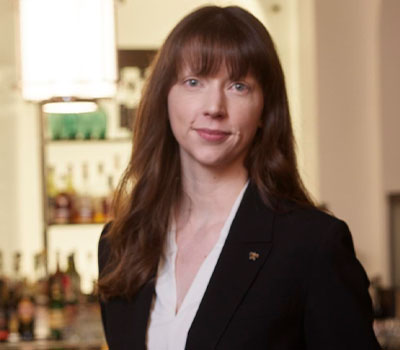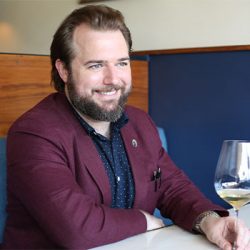Erin Healy started at Restaurant Daniel as wine director in July 2023. At work, she finds it’s easier to use the term chef sommelier: “There’s a lot of speaking of French around the building, so it just makes more sense rather than to hop between the two.” Healy is, in fact, fluent in French, having adopted Champagne as a second home—starting in high school, when she studied there and lived with a family with whom she is still close. Her language skills and ex-State Department diplomacy skills have proven valuable in her career, especially at Daniel, where she finds the French culture of the dining room is insulated from the contemporary trends toward cocktails or low abv drinks. Wine is number one at Daniel, she says. “Wine has been number one and wine will be number one. And I don’t think that that will ever change in the existence of this restaurant. That’s the exciting thing about working with a list like the Restaurant Daniel wine list: People come here to drink wine.” —Joshua Greene


• The Ageability of Bordeaux
The interesting personalities of the wines in Bordeaux—how they develop and how they grow up—is something that never ceases to excite me when I get to touch those bottles, when I get to think about what happened in those years, when I get to think about how it’s showing and where it’s at in its life.
In Bordeaux, we do sell a lot of Premier Grand Cru Classé—a fair amount of Latour and Mouton—and those things almost sell themselves. Where we see the most volume is in the category of second growths, the great second growths. So things like Las Cases, Cos d’Estournel, the Pichon Comtesses of the world, that’s definitely where I think people gravitate the most to. I wouldn’t necessarily say it’s just Pauillac, but Left Bank Bordeaux is definitely where we see the most interest.
I am a huge fan of Las Cases, especially right now. And the 1989 Las Cases is an absolute stunner. It’s so pretty. The fruit is so silky and soft and pure. It’s really has this beautiful, floral rose and tobacco situation going on right now. It’s all about purity with the ’89.
Recently, I was cataloging a big order of Bordeaux that we had got in with a lot of very, very old wine and opening up these cases and just looking at the fill level. We had a bottle of ’78 Margaux, and the fill was quite low; we opened it pretty soon after getting it because it was someone’s birth year and they were very excited to taste it. I wasn’t particularly sure how this wine was going to be. And it was absolutely stunning, it was in such a beautiful place. It was so floral, it was bright, there was fruit. And did it last all night? No, but I think Bordeaux is one of those areas of wine that (A), you get the opportunity to open old things in a way that you don’t have access to in other regions.
But then (B), also those surprises happen, those exciting moments when the fill is down to the elbow of the bottle and it’s from a mixed-bag vintage and you get a beautiful wine and you get to have that moment of childlike excitement where you could analyze it all day long. Ultimately, this is an old wine that probably shouldn’t be this good and is showing you all the signs that it wouldn’t be that good and then ends up being just a stunning example of what great wine is.
• Champagne on the list
I’m very excited about the Domaine Le Monts Fournois wines. It’s a project by the Bérêche family birthed out of the old Côte Wines, the negoce wines they used to produce. But they then started making Coteaux Champenois in this vineyard Le Monts Fournois, which is in Ludes, and they wanted to create a different domain surrounding this vineyard and the great grands crus of Champagne and have partnered up with a cousin of the family, Juliette [Alips], who is a super-energetic, really brilliant young woman. And so while they’re getting the project started, while they’re developing this vineyard and getting the wines to where they want them to be, they created these partnerships with growers in the grands crus villages and are producing single vintage pictures of grand cru village wines. They aren’t single-parcel wines. It’s not about the specific sense of place as it is a picture of that grand cru. And I think the wines are outstanding.
One of the more special bottles is the 2017 Oger Grand Cru, which is a Blanc de Blancs. It’s got so much texture, so much density, so much savory expression with chardonnay that I think sometimes is lacking these days in Champagne—I think that is a product of that kind of Extra Brut, Brut Nature fashion that existed for quite a long time, which is kind of balanced out a little bit now. I think there was a lot of talk about purity of chardonnay, which I think is still super important, but it also makes me miss sometimes a little bit of those brioche bombs.
This wine really achieves that purity of chardonnay, while also giving you that sense of decadence that I think is so important, especially with vintage Champagne. We still see a little bit of that in more pinot noir-driven styles, but with chardonnay, the trend has moved away from that. And I really appreciate those kind of decadent wines, Champagnes that make you feel a little guilty when you drink them. And it’s a sexy wine. It’s food friendly. And it’s a real great way to look at Champagne in a very classic sense, rather than it being a way to look at Champagne through a more nuanced winemaker vision, with the winemaking all the same. It’s a little bit less of a conversation of single-vineyard terroir, but more of just what is this greater place?
• Burgundy south the Rhône
At Restaurant Daniel, all roads lead to Burgundy at the end of the day. Between Bordeaux and Burgundy, Burgundy is probably the most important pillar of our wine list. Beyond that, Daniel’s being from the Rhône Valley, he’s from Lyon, those cuisine traditions, his love for Côte Rôtie, Hermitage, I think it kind of seeps into the wine list. And his history and his love for that area definitely is super important because people like to indulge there and it’s great for our food.
Personally, what I’ve seen very well received that I would like to grow, not just based on personal preference, but also based on guest reaction, is White Rhône. The demand, or the receptivity of our guests to connect with something like Condrieu is amazing. I think viognier is totally underrated, and I think some of the great whites of the world are viognier based. And being able to sell Chateau Grillet at a rate that I’ve never been able to sell it and have people really receptive to spending that kind of money on these wines and then really love them.
There’s a lot of white Rhône out there that maybe gets overlooked or underappreciated. And this is definitely a restaurant where people are super open to moving into white Rhône. I don’t know that’s because of people’s affinity for white Burgundy here, and being willing to sidestep out of that when it’s the right wine. But also, that cultural heritage with the Rhône itself and people’s knowledge of the Boulud history and their curiosity about the whites and having not tasted them.
This restaurant is so much about the relationship between our team and Daniel and the wine team with the guests that we have. And we have so many regulars who come back on a weekly basis or people that we’ve developed these relationships with over a very, very long time. There are six of us on the wine team developing those relationships. We are known for Burgundy, Bordeaux, Rhône, some Champagne, and it doesn’t really stray out of those categories all that often. But I will say this team was super excited about Château-Grillet. I saw so much white Rhône going out on tables because our team was excited about it and we were pushing it—a category that is a little more esoteric, I think, for some of our guests—a category that we’ve seen growth in when it comes to what people are drinking.
• The most exciting bottle of 2023…
The tastiest thing I opened last year was Guigal’s 1992 La Mouline. I like to describe Syrah as this grape that has, when it ages and develops, it gets a second life at one point. And that in its first life, the sweetness of fruit is coming from that kind of cassis, blackberry kind of fruit. And you get all those savory tones, but the savory tones are a little bit more rugged and can feel a bit rustic and intense. And then when it gets to the second life, you get another kind of sweetness from the wine, but it’s from a sweet black olive and you get fruitiness from it. But the fruitiness is from that kind of olive, that olive quality.
It’s this wild thing where you get sweetness of fruit in its second life, but it’s not like fruit when we think about blackberry or plum, it comes from this sweet olive fruitiness and it feels very youthful and vibrant even though it’s a product of development. And I remember opening it with chef in the dining room and he was walking around and he saw it on the cart and he walks over and we all kind of tasted it together with the table. And they’re just real pleasure wines. Old syrah when they’re still in that sweet olive state. And they’ve really kind of, I feel like it’s like a time capsule that you put away and you open up and it kind of blossoms again. I’ve only ever had syrah do that, where it finds a second youth in that specific way. When the French ask you, when the first question of the French ask, you when you taste something is, do you like it? Does it bring you pleasure? That wine is what pleasure is.
Joshua Greene is the editor and publisher of Wine & Spirits magazine.
This is a W&S web exclusive. Get access to all of our feature stories by signing up today.




















